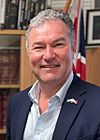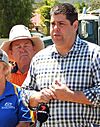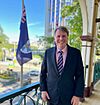Queensland Government facts for kids
Quick facts for kids Queensland Government |
|
|---|---|
 |
|
| Overview | |
| Established |
|
| State | Queensland |
| Leader | Premier (David Crisafulli) |
| Appointed by | Governor (Jeannette Young) on the advice of the premier |
| Main organ | Cabinet |
| Ministries | 22 government departments |
| Responsible to | Legislative Assembly of Queensland |
| Annual budget | |
| Headquarters | 1 William Street, Brisbane |
The Queensland Government is the group of people and departments that run the state of Queensland, Australia. It's like the management team for the whole state! This government is formed by the political party or group that wins the most votes in the Queensland Legislative Assembly. The Governor of Queensland officially appoints the people who hold important jobs.
Queensland first got its own government in 1859. This happened when Queensland became separate from New South Wales. Since 1901, when Australia became one country (called Federation), Queensland has been a state within Australia. The rules for how the Queensland Government works are set by the Constitution of Australia.
Queensland's government is similar to the system used in the United Kingdom. It also works within Australia's larger federal system. The Governor of Queensland represents the King, Charles III. The Governor officially approves government actions. However, in everyday life, the real decisions are made by the Cabinet. The Cabinet is the main group that makes important plans and decisions for the state. It includes the Premier and other senior ministers. Each minister is in charge of a specific government department. They make sure policies and laws are put into action.
Most government departments have their main offices in Brisbane, the capital city. Many are located in a tall building called 1 William Street.
Contents
What is the Queensland Government?
Queensland's government follows a system called the Westminster system. This is a type of government based on the model used in the United Kingdom. The power to make laws belongs to the Parliament of Queensland. This Parliament includes the King (represented by the Governor of Queensland) and one main group of elected people, called the Legislative Assembly of Queensland.
Officially, the power to run the state belongs to the Executive Council. This council includes the Governor and senior ministers. But in reality, the state Cabinet makes most of the decisions and carries them out.
The Governor and the Premier: Who Does What?
The Governor represents the King and holds the formal power. They act on the advice of the Premier of Queensland and the Cabinet. The Premier and other ministers are chosen by the Governor. They keep their jobs as long as they have the support of most members in the Legislative Assembly.
Meet the Leaders: Queensland's Current Ministers
The current team of leaders, called the ministry, was sworn in on November 1, 2024. This team is led by the Premier, David Crisafulli, and the Deputy Premier, Jarrod Bleijie. They work together with other ministers to manage different areas of Queensland.
| Portrait | Minister | Portfolio | Took office | Left office | Duration of tenure | Party | Electorate | |
|---|---|---|---|---|---|---|---|---|
| Cabinet Ministers | ||||||||
 |
David Crisafulli |
|
28 October 2024 | Incumbent | 1 year, 83 days | Liberal National | Broadwater | |
 |
Jarrod Bleijie |
|
28 October 2024 | Incumbent | 1 year, 83 days | Kawana | ||
| David Janetzki |
|
1 November 2024 | Incumbent | 1 year, 79 days | Toowoomba South | |||
 |
Ros Bates |
|
1 November 2024 | Incumbent | 1 year, 79 days | Mudgeeraba | ||
 |
Tim Nicholls |
|
1 November 2024 | Incumbent | 1 year, 79 days | Clayfield | ||
 |
Deb Frecklington |
|
1 November 2024 | Incumbent | 1 year, 79 days | Nanango | ||
| Dale Last |
|
1 November 2024 | Incumbent | 1 year, 79 days | Burdekin | |||
 |
John-Paul Langbroek |
|
1 November 2024 | Incumbent | 1 year, 79 days | Surfers Paradise | ||
| Dan Purdie |
|
1 November 2024 | Incumbent | 1 year, 79 days | Ninderry | |||
| Laura Gerber |
|
1 November 2024 | Incumbent | 1 year, 79 days | Currumbin | |||
 |
Brent Mickelberg |
|
1 November 2024 | Incumbent | 1 year, 79 days | Buderim | ||
| Ann Leahy |
|
1 November 2024 | Incumbent | 1 year, 79 days | Warrego | |||
| Sam O'Connor |
|
1 November 2024 | Incumbent | 1 year, 79 days | Bonney | |||
| Tony Perrett |
|
1 November 2024 | Incumbent | 1 year, 79 days | Gympie | |||
| Fiona Simpson |
|
1 November 2024 | Incumbent | 1 year, 79 days | Maroochydore | |||
| Andrew Powell |
|
1 November 2024 | Incumbent | 1 year, 79 days | Glass House | |||
| Amanda Camm |
|
1 November 2024 | Incumbent | 1 year, 79 days | Whitsunday | |||
| Tim Mander |
|
1 November 2024 | Incumbent | 1 year, 79 days | Everton | |||
 |
Steve Minnikin |
|
1 November 2024 | Incumbent | 1 year, 79 days | Chatsworth | ||
 |
Christian Rowan |
|
1 November 2024 | Incumbent | 1 year, 79 days | Moggill | ||
Helping Queensland: Government Departments
The Queensland Government has many departments. Each department focuses on a different area to help the state run smoothly. These departments provide important services to people living in Queensland.
Here are some of the main departments that help run Queensland today:
- Department of Customer Services, Open Data and Small and Family Business
- Department of Education (for schools and learning)
- Department of Environment, Tourism, Science and Innovation (for nature, holidays, and new discoveries)
- Department of Families, Seniors, Disability Services and Child Safety (for supporting families and vulnerable people)
- Department of Housing and Public Works (for homes and government buildings)
- Department of Justice (for laws and courts)
- Department of Local Government, Water and Volunteers (for local councils, water, and community helpers)
- Department of Natural Resources and Mines, Manufacturing and Regional and Rural Development (for land, resources, and jobs)
- Department of the Premier and Cabinet (helps the Premier lead the government)
- Department of Primary Industries (for farming, fishing, and food)
- Queensland Corrective Services (manages prisons and rehabilitation)
- Queensland Fire Department (for fire safety and emergencies)
- Queensland Health (Department of Health) (for hospitals and health services)
- Queensland Police Service (for keeping communities safe)
- Queensland Treasury (manages the state's money)
- Department of Sport, Racing and Olympic and Paralympic Games (for sports and big events)
- Department of State Development, Infrastructure and Planning (for big projects and future plans)
- Department of Trade, Employment and Training (for jobs and skills)
- Department of Transport and Main Roads (for roads, public transport, and travel)
- Department of Women, Aboriginal and Torres Strait Islander Partnerships and Multiculturalism (for supporting diverse communities)
- Department of Youth Justice and Victim Support (for young people in the justice system and helping victims)
Many other agencies also help these departments do their work.
See also
 In Spanish: Gobierno de Queensland para niños
In Spanish: Gobierno de Queensland para niños
- Politics of Queensland
- Women in the Queensland Legislative Assembly

